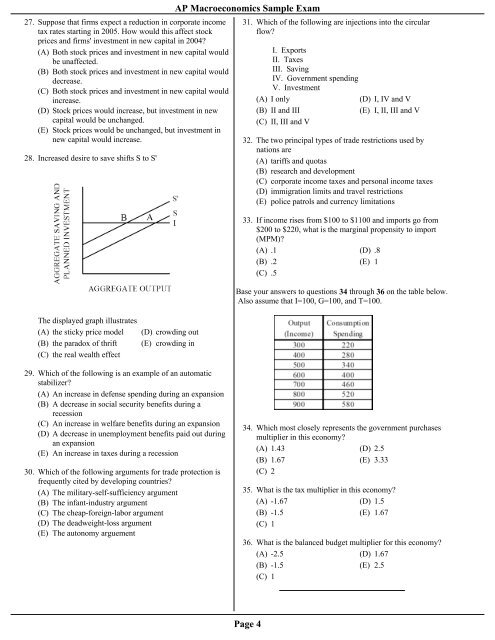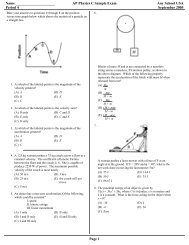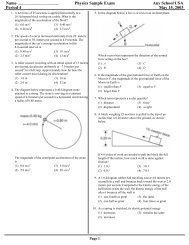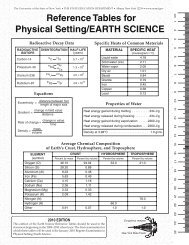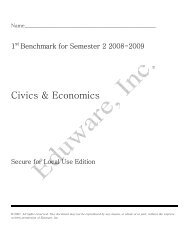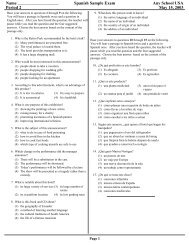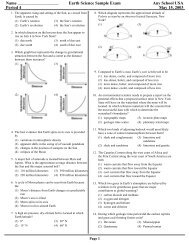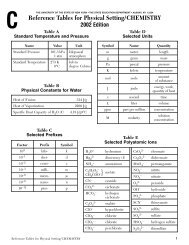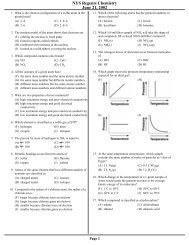The Wizard Test Maker - Eduware
The Wizard Test Maker - Eduware
The Wizard Test Maker - Eduware
Create successful ePaper yourself
Turn your PDF publications into a flip-book with our unique Google optimized e-Paper software.
27. Suppose that firms expect a reduction in corporate income<br />
tax rates starting in 2005. How would this affect stock<br />
prices and firms' investment in new capital in 2004<br />
(A) Both stock prices and investment in new capital would<br />
be unaffected.<br />
(B) Both stock prices and investment in new capital would<br />
decrease.<br />
(C) Both stock prices and investment in new capital would<br />
increase.<br />
(D) Stock prices would increase, but investment in new<br />
capital would be unchanged.<br />
(E) Stock prices would be unchanged, but investment in<br />
new capital would increase.<br />
28. Increased desire to save shifts S to S'<br />
AP Macroeconomics Sample Exam<br />
31. Which of the following are injections into the circular<br />
flow<br />
I. Exports<br />
II. Taxes<br />
III. Saving<br />
IV. Government spending<br />
V. Investment<br />
(A) I only<br />
(D) I, IV and V<br />
(B) II and III<br />
(E) I, II, III and V<br />
(C) II, III and V<br />
32. <strong>The</strong> two principal types of trade restrictions used by<br />
nations are<br />
(A) tariffs and quotas<br />
(B) research and development<br />
(C) corporate income taxes and personal income taxes<br />
(D) immigration limits and travel restrictions<br />
(E) police patrols and currency limitations<br />
33. If income rises from $100 to $1100 and imports go from<br />
$200 to $220, what is the marginal propensity to import<br />
(MPM)<br />
(A) .1 (D) .8<br />
(B) .2 (E) 1<br />
(C) .5<br />
Base your answers to questions 34 through 36 on the table below.<br />
Also assume that I=100, G=100, and T=100.<br />
<strong>The</strong> displayed graph illustrates<br />
(A) the sticky price model<br />
(B) the paradox of thrift<br />
(C) the real wealth effect<br />
(D) crowding out<br />
(E) crowding in<br />
29. Which of the following is an example of an automatic<br />
stabilizer<br />
(A) An increase in defense spending during an expansion<br />
(B) A decrease in social security benefits during a<br />
recession<br />
(C) An increase in welfare benefits during an expansion<br />
(D) A decrease in unemployment benefits paid out during<br />
an expansion<br />
(E) An increase in taxes during a recession<br />
30. Which of the following arguments for trade protection is<br />
frequently cited by developing countries<br />
(A) <strong>The</strong> military-self-sufficiency argument<br />
(B) <strong>The</strong> infant-industry argument<br />
(C) <strong>The</strong> cheap-foreign-labor argument<br />
(D) <strong>The</strong> deadweight-loss argument<br />
(E) <strong>The</strong> autonomy arguement<br />
34. Which most closely represents the government purchases<br />
multiplier in this economy<br />
(A) 1.43 (D) 2.5<br />
(B) 1.67 (E) 3.33<br />
(C) 2<br />
35. What is the tax multiplier in this economy<br />
(A) -1.67 (D) 1.5<br />
(B) -1.5 (E) 1.67<br />
(C) 1<br />
36. What is the balanced budget multiplier for this economy<br />
(A) -2.5 (D) 1.67<br />
(B) -1.5 (E) 2.5<br />
(C) 1<br />
Page 4


